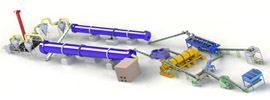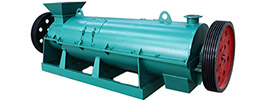The treatment of cattle manure in cattle farms must balance environmental protection, resource utilization, and economic benefits. The following scientific methods enable efficient processing and circular utilization:
I. Physical Treatment: Basic Reduction and Pretreatment
- Solid-Liquid Separation
- Equipment: Use screw extruders, centrifuges, or vibrating screens to separate cattle manure into solid (30%-40% solids content) and liquid (5%-10% solids content) fractions.
- Purpose: Reduce the difficulty of subsequent treatment. The solid fraction is suitable for composting or fuel production, while the liquid fraction can be further purified or used for irrigation.
- Drying Treatment
- Natural Sun-Drying: Suitable for small-scale farms, with low cost but a long cycle (10-15 days).
- Mechanical Drying: Rapidly dehydrate manure using rotary dryers or hot air furnaces, reducing moisture content to below 15% for easier storage and transportation.
II. Biological Treatment: Core of Resource Utilization
- Composting (Aerobic Fermentation)
- Process: Mix solid manure with straw, sawdust, or other bulking agents to adjust the carbon-to-nitrogen ratio (25-30:1) and moisture content (50%-60%). Promote microbial decomposition through turning or forced aeration.
- Products: Organic fertilizer (NPK content ≥5%) for improving soil structure in farmland.
- Advantages: Low cost, complete harmless treatment, and compliance with organic farming standards.
- Anaerobic Digestion (Biogas Engineering)
- Process: Feed liquid or whole manure into a biogas digester for fermentation at 35-55°C (mesophilic conditions), producing biogas (methane content 50%-70%) and digestate.
- Products:
- Biogas: Used for power generation, heating, or cooking (0.3-0.5 m³ of gas per m³ of manure).
- Digestate: Can be dewatered and used as organic fertilizer or substrate material.
- Advantages: High energy recovery and reduced greenhouse gas emissions.
- Vermicomposting (Biological Transformation)
- Process: Mix manure with humus and introduce earthworm species like Eisenia fetida for organic matter decomposition.
- Products:
- Earthworms: Used as protein feed or medicinal resources.
- Vermicompost: High-quality organic fertilizer rich in humic acids and beneficial microorganisms.
- Advantages: Achieves a closed-loop "waste-to-resource" system with high added value.
III. Energy Utilization: Clean Alternative Solutions
- Biomass Fuel Production
- Pelletizing/Briquetting: Compress dried manure into pellets or briquettes with a calorific value of 12-18 MJ/kg, replacing coal in boilers or drying equipment.
- Gasification: Convert manure into combustible gas (CO + H₂) via high-temperature gasifiers for power generation or heating.
- Direct Combustion (Use with Caution)
- Conditions: Only applicable to dry manure with moisture content below 20%, requiring dust removal equipment to reduce particulate emissions.
- Limitations: Low thermal efficiency (~30%) and potential dioxin emissions, necessitating strict environmental approvals.
IV. Ecological Utilization: Returning to Natural Cycles
- Insect Farming
- Black Soldier Fly (BSF): Larvae efficiently decompose manure into high-protein feed (40%-50% crude protein).
- Housefly Larvae: Cultivate larvae for aquaculture or poultry feed.
- Edible Mushroom Cultivation
- Process: Mix manure with cottonseed hulls or corn cobs as substrate for cultivating mushrooms like Pleurotus or Lentinula.
- Advantages: High substrate utilization rate; spent mushroom substrate can be further composted.
V. Recommended Integrated Treatment Models
- "Biogas + Composting" Model
- Liquid manure → Biogas plant → Biogas for power/heat; digestate → Composting → Organic fertilizer.
- Solid manure → Direct composting or blending with digestate for land application.
- "Drying + Fuel" Model
- Manure → Drying → Pelletizing → Biomass fuel to replace fossil energy.
- "Vermicomposting + Mushroom" Model
- Manure → Earthworm farming → Vermicompost → Mushroom cultivation → Spent substrate returned to fields.
VI. Balancing Environmental and Economic Considerations
- Regulatory Compliance: Ensure treatment facilities meet standards in regulations like China’s Livestock and Poultry Breeding Pollution Prevention and Control Regulations to avoid fines.
- Cost Optimization: Select methods based on farm scale (e.g., composting for small farms, biogas for large farms).
- Market Integration: Partner with organic farms, biomass power plants, or feed enterprises to expand product sales channels.
- Technology Upgrades: Adopt smart equipment (e.g., automatic compost turners, biogas monitoring systems) to improve efficiency.
By combining these methods scientifically, cattle farms can transform manure into clean energy, organic fertilizers, or high-value products, achieving a win-win for environmental and economic sustainability.
 Send us a Email
Send us a Email Wulong Industrial Cluster
Wulong Industrial Cluster Have any question?
Have any question?


















